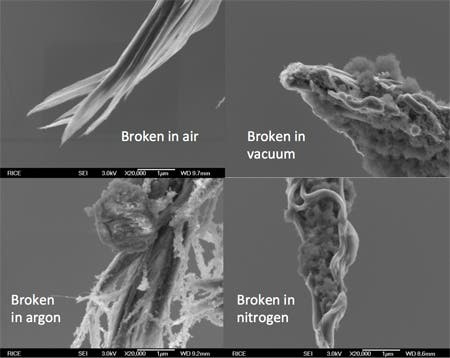Reliable, well supplied and with years and years of manufacturing experience behind it, copper is the most widespread material used for delivering electrical charge. Some applications warrant more efficient materials, though, and researchers at Rice recently showed that carbon nanotubes spun into fiber can carry four times as much electrical charge than copper cables of the same mass.
Of course, carbon nanotubes taken individually can deliver 1,000 times more current than copper, but real-world applications require macroscopic conductors. Previous attempts at mustering carbon nanotubes for high power electrical charge failed, however Rice University researchers demonstrated that wet-spun carbon nanotube fiber is a good alternative.
Rice professors Junichiro Kono and Matteo Pasquali developed a strong and flexible cable even though at 20 microns wide, it’s thinner than a human hair. For benchmark purposes, the researchers analyzed the “current carrying capacity” (CCC), or ampacity, of the nanotube fiber against that of copper cables. Four mediums were chosen for this analysis: open air, in a vacuum and in nitrogen or argon environments.

The number one cause of electrical cable failure is overheating. When current passes through a conductor, it also produces heat because of the material’s resistivity. When temperatures exceed rated values, the cable gets too hot, breaks and, of course, can potentially become a fire hazard. Concerning the carbon nanotube fibers, those working in nitrogen atmosphere proved to have the best CCC, followed by argon and open air, all of which were able to cool through convection. The same nanotube fibers in a vacuum could only cool by radiation and had the lowest CCC.
“The outcome is that these fibers have the highest CCC ever reported for any carbon-based fibers,” Kono said. “Copper still has better resistivity by an order of magnitude, but we have the advantage that carbon fiber is light. So if you divide the CCC by the mass, we win.”
Ever carried a copper or aluminium cable? That’s some heavy gear, but not because of the conducting material itself, but rather because both copper and aluminium don’t have a high tensile strength, a heavy steel-core reinforcement is needed to support the cable. In applications where weight is an important factor to consider, like aerial or spacial projects, carbon nanotube fiber could prove to be a better option, according to the Rice scientists.
Pasquali even suggested the thread-like fibers are light enough to deliver power to aerial vehicles. We’ve heard of wackier stuff work.
“Suppose you want to power an unmanned aerial vehicle from the ground,” he mused. “You could make it like a kite, with power supplied by our fibers. I wish Ben Franklin were here to see that!”
Details were published in the journal Nanoscale. [story via Kurzeweil]






